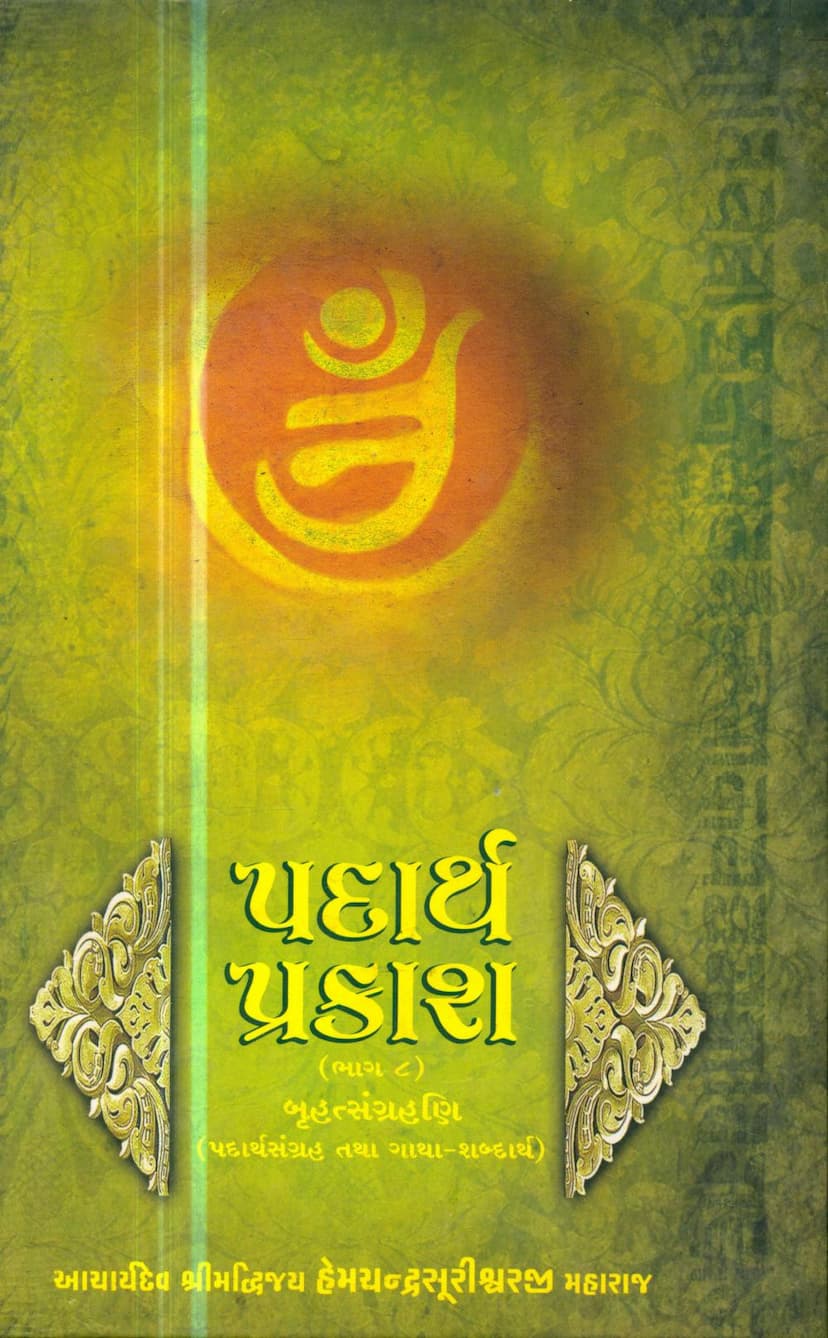Padarth Prakash Part 08
Added to library: September 2, 2025

Summary
This is a comprehensive summary of the Jain text "Padarth Prakash Part 08," authored by Hemchandrasuri and published by Sanghavi Ambalal Ratanchand Jain Dharmik Trust.
Book Title: Padarth Prakash Part 08 (Gujarati: પદાર્થ પ્રકાશ ભાગ ૮) Author: Acharya Shrimad Vijay Hemchandrasurishwarji Maharaj (Gujarati: પરમપૂજ્ય વૈરાગ્યદેશનાદક્ષ આચાર્યદેવ શ્રીમદ્વિજય હેમચન્દ્રસૂરીશ્વરજી મહારાજ) Publisher: Sanghavi Ambalal Ratanchand Jain Dharmik Trust (Gujarati: સંઘવી અંબાલાલ રતનચંદ જૈન ધાર્મિક ટ્રસ્ટ) Catalog Link: https://jainqq.org/explore/023418/1
Core Content and Purpose:
This volume, "Padarth Prakash Part 08," is a compilation and elaboration of the "Brihat Sangrahani" (Gujarati: બૃહત્સંગ્રહણિ). Its primary purpose is to present the essential "padarthas" (principles or substances) and the meanings of the verses (gathas) from this foundational Jain text in a concise and accessible manner. The book aims to facilitate the study and memorization of these complex Jain doctrines.
Key Subjects Covered:
The text focuses on the principles related to the lifespans, dwelling places, physical dimensions (avamgahan), birth and death counts (upapat-chyavan sankhya), periods of non-existence between birth and death (upapat-chyavan virahkal), movement (gati), and return (aagti) of beings across the four realms of existence:
- Devas (Gods): Detailed information about various classes of celestial beings, their celestial vehicles (vimanas), their abodes (bhavan), lifespans, and hierarchical structures.
- Narkis (Hell beings): Extensive coverage of the seven hellish realms, the lifespans, dwelling places, and the intense suffering experienced by their inhabitants due to their actions and the nature of those realms.
- Tiryancho (Animals/Lower beings): Principles related to beings in the animal kingdom, covering their lifespans, forms, and existences.
- Manushya (Humans): Details regarding human lifespans, physical characteristics, and their place in the cosmos.
Methodology and Structure:
The book follows a systematic approach, organizing the information based on the structure of the Brihat Sangrahani. It breaks down complex topics into "dwaras" (gateways or sections) for easier understanding. The text explains the lineage and commentaries of the original works:
- Brihat Sangrahani: Composed by Acharya Jinbhadra Gani Kshama Shramana (Gujarati: શ્રીજિનભદ્રગણિ ક્ષમાશ્રમણજી મહારાજ) with commentary by Shri Malayagiri Maharaj (Gujarati: શ્રીમલયગિરિ મહારાજે).
- Sangrahani Sutra: Composed by Shri Shrichandra Suri (Gujarati: શ્રી શ્રીચન્દ્રસૂરિ મહારાજ) with commentary by Shri Devbhadra Suri (Gujarati: શ્રીદેવભદ્રસૂરિ મહારાજે).
The book includes:
- Padarth Sangrah (Collection of Principles): A structured breakdown of the key concepts and classifications.
- Mool Gatha-Shabdarth (Original Verses and Word Meanings): The original verses of the Brihat Sangrahani and Sangrahani Sutra are provided along with their Gujarati meanings for deeper study and memorization.
- Tabulated Data: Extensive use of tables to present numerical data, lifespans, dimensions, and classifications of beings, making the information easily digestible.
- Visual Aids: Inclusion of diagrams and illustrations (mentioned at the end of the book) to visually represent the concepts discussed, such as the structure of the universe, celestial realms, and hellish realms.
- Comparative Analysis: Where differences exist between the Brihat Sangrahani and Sangrahani Sutra, these are noted.
Pedagogical Approach:
The publication emphasizes the method initiated by the preceding Acharyas, Prem Surishwarji Maharaj and Bhuvan Bhanu Surishwarji Maharaj, of condensing and presenting scriptural principles for efficient learning. The goal is to enable students to acquire significant knowledge with minimal effort, aiding in retention through repetition and contemplation.
Spiritual Significance:
The underlying philosophy highlights the importance of controlling the mind, as stated by Anandghanji Maharaj ("Man Sadhya Satelu Saglu Sadhya" - "He who has controlled his mind has achieved everything"). The text underscores that the study of these scriptural principles is a vital tool for focusing the mind on auspicious thoughts, thereby mitigating the accumulation of negative karma and facilitating spiritual progress towards liberation (moksha).
Dedication and Acknowledgements:
The book is dedicated to the inspiration and guidance of the author's gurus. It also expresses gratitude to Panditvar Paryas Chamanlal Shah for reviewing the content. The publication is presented as a service by the Sanghavi Ambalal Ratanchand Jain Dharmik Trust, established for philanthropic and religious purposes.
Overall, "Padarth Prakash Part 08" serves as a crucial resource for Jain scholars and students seeking to understand the intricate details of the cosmos, the nature of different life forms, and the fundamental principles of Jain metaphysics as elaborated in the Brihat Sangrahani and Sangrahani Sutra.